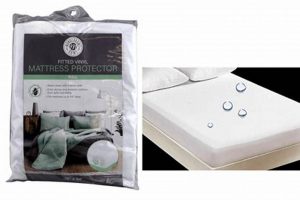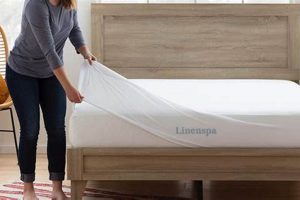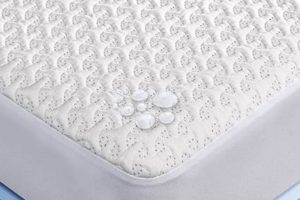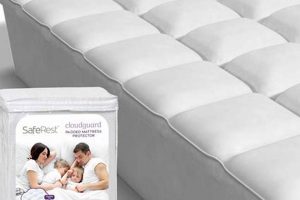The question of whether encasements offer defense against infestation is frequently posed. These specially designed covers are intended to create a barrier around a bed. The effectiveness of such protection hinges on several factors, including the quality of the material, the tightness of the weave, and proper installation.
Utilizing a suitable encasement offers several advantages. It can prevent existing infestations within a mattress from escaping and biting. Furthermore, it can deter new infestations from establishing themselves inside the bedding. Historically, simple coverings were used to protect mattresses from dust and spills; modern iterations are specifically engineered to combat microscopic pests.
Exploring the characteristics of effective barriers, understanding the different types available, and adopting recommended practices for installation and maintenance will contribute to a well-informed decision regarding the suitability of this preventative measure. This discussion will examine these facets to provide a comprehensive perspective.
Mitigating Infestation Risk
Employing specific measures can significantly reduce the likelihood of infestation. These strategies focus on prevention, detection, and proper maintenance. Consistent adherence to these guidelines is paramount for optimal protection.
Tip 1: Select a High-Quality Encasement: Prioritize products specifically designed for pest control. The encasement should feature a tightly woven fabric with pore sizes too small for pests to penetrate. Consider materials that are waterproof and durable.
Tip 2: Inspect Encasements Regularly: Conduct thorough examinations of the encasement’s surface, seams, and zipper areas. Look for any signs of damage, such as tears or punctures, which could compromise its protective capabilities. Address any damage promptly with repair or replacement.
Tip 3: Install the Encasement Properly: Follow the manufacturer’s instructions meticulously during installation. Ensure the entire mattress is completely enclosed, and that the zipper is fully sealed. Improper installation renders the encasement ineffective.
Tip 4: Maintain a Clean Sleeping Environment: Regularly wash bedding, including sheets, pillowcases, and blankets, in hot water and dry on high heat. Vacuum the mattress and surrounding areas frequently to remove potential food sources for pests.
Tip 5: Be Vigilant When Traveling: Inspect hotel rooms for signs of infestation before settling in. Store luggage away from beds and upholstered furniture. Upon returning home, immediately wash all clothing and thoroughly inspect luggage.
Tip 6: Consider Professional Assistance: For existing infestations or persistent concerns, consult with a qualified pest control professional. Professional treatments can effectively eliminate pests and prevent future infestations.
By implementing these strategies, the risk of encountering infestation can be significantly decreased. Consistent vigilance and proactive measures are essential for maintaining a pest-free sleeping environment.
The subsequent sections will explore further aspects of pest control and preventative measures, providing a comprehensive understanding of this issue.
1. Barrier
The concept of a “barrier” is fundamental to understanding the effectiveness of a mattress protector in preventing or managing infestation. The primary function relies on its ability to physically obstruct the pests’ access to and from the mattress.
- Physical Impediment
The most straightforward role is the physical barrier a tightly woven material provides. This prevents pests from burrowing into the mattress’s fibers, where they typically reside and reproduce. Without this barrier, the mattress becomes a readily available habitat.
- Containment of Existing Infestations
In cases where a mattress is already infested, a properly installed protector can serve to contain the pests. This prevents them from escaping and spreading to other areas of the room or even other dwellings. This containment strategy relies on the protector remaining intact and sealed.
- Detection Facilitation
A white or light-colored protector makes the detection of pests easier. The dark fecal matter and bloodstains associated are more readily visible against a light background. This allows for early identification of an infestation, enabling quicker intervention.
- Mitigation of Allergen Exposure
Beyond the pests themselves, protectors can reduce exposure to allergens. These allergens, present in shed skins and fecal matter, can trigger allergic reactions in sensitive individuals. By containing these materials, the protector minimizes the potential for respiratory distress and skin irritation.
These facets of the “barrier” concept underscore its significance. A compromised barrier, whether due to poor material quality, improper installation, or damage, negates these benefits and renders the protector ineffective in preventing or managing infestations. Therefore, the selection and maintenance of a robust and intact barrier are crucial considerations.
2. Material Quality
The composition of a mattress encasement directly impacts its effectiveness in preventing infestation. The type of material used, along with its construction, determines the encasement’s ability to act as a barrier.
- Pore Size and Weave Density
The material’s weave density and pore size are critical. An effective encasement must have pores smaller than the smallest nymph stage. Materials like tightly woven polyester or microfiber offer superior protection compared to loosely woven fabrics such as cotton or blends with larger pore sizes. A smaller pore size physically prevents penetration.
- Durability and Resistance to Tearing
The material’s ability to withstand daily wear and tear is essential. A protector constructed from a durable material is less likely to develop rips or tears, which would compromise its integrity. Materials such as polyurethane-backed fabrics offer increased tear resistance, providing long-term protection. Damage to the material effectively negates its ability to stop pests.
- Waterproof or Water-Resistant Properties
Waterproof or water-resistant materials contribute to a cleaner sleeping environment and indirectly assist in infestation prevention. By preventing moisture from seeping into the mattress, these materials reduce the likelihood of mold and mildew growth, which can attract other pests and create a more hospitable environment for infestation. While not directly preventing infestation, moisture resistance supports overall hygiene.
- Breathability and Comfort
While protection is paramount, breathability influences comfort. Non-breathable materials can trap heat and moisture, leading to discomfort and potentially damaging the mattress over time. Materials that offer a balance of protection and breathability, such as certain laminated fabrics or those with specialized coatings, are preferable for long-term use. However, breathability should not compromise the essential function of preventing pest penetration.
In summary, material quality directly influences an encasement’s protective capabilities. Selecting a protector constructed from a durable, tightly woven material with small pore sizes is essential for effectively preventing or containing infestation. The presence of waterproofing and adequate breathability further enhance the product’s value and contribute to a healthier sleep environment, although the primary focus remains on preventing penetration.
3. Proper Encasement
The efficacy of a mattress protector in stopping the advance or spread of infestation is inextricably linked to its correct application. “Proper encasement” involves a multi-faceted approach encompassing selection, installation, and maintenance, all contributing to the creation of an impenetrable barrier.
- Correct Size and Fit
An encasement must precisely fit the dimensions of the mattress. An oversized encasement may leave gaps or folds, providing harborage for pests. Conversely, an undersized encasement may stretch the material, weakening the weave and potentially creating entry points. Accurate measurements and adherence to manufacturer specifications are crucial to ensure a snug, secure fit.
- Secure Closure Mechanisms
The closure mechanism, typically a zipper, represents a potential vulnerability. A zipper with large teeth or gaps can allow passage. Encasements should feature fine-toothed, tightly closing zippers with a locking mechanism or Velcro flap to secure the end and prevent accidental openings. Regular inspection of the zipper’s integrity is necessary.
- Thorough Installation Procedures
Proper installation is not merely sliding the encasement over the mattress. It requires a systematic approach, ensuring all sides and corners are fully covered. Instructions provided by the manufacturer should be followed diligently. The encasement should be carefully maneuvered to avoid stressing the seams or material, which could lead to tears or weakening. Attention to detail during installation is paramount.
- Regular Inspection and Maintenance
An encasement is not a one-time application. Regular inspections are essential to identify any signs of damage, such as rips, tears, or zipper malfunctions. Minor damage should be repaired promptly using appropriate patching techniques. Heavily damaged encasements should be replaced. Periodic cleaning, following the manufacturer’s guidelines, can help maintain the encasement’s integrity and hygiene.
The combined effect of selecting the correct size, ensuring secure closure, following meticulous installation procedures, and performing routine inspections transforms a simple mattress cover into a robust defense against infestation. Failure to adhere to these principles of “proper encasement” compromises the protective capabilities of the product, rendering it largely ineffective in stopping or managing these infestations.
4. Zipper Integrity
The efficacy of a mattress protector in preventing or containing an infestation is critically dependent upon the integrity of its closure mechanism, primarily the zipper. A compromised zipper undermines the entire premise of the encasement, negating its protective capabilities.
- Material and Construction
The zipper’s material and construction are fundamental to its durability and reliability. Zippers constructed from robust materials, such as metal or high-density polymers, are more resistant to breakage and wear than those made from weaker materials. The design should incorporate tightly interlocking teeth that create a secure seal when closed. Examples of superior construction include zippers with reinforced stitching along the fabric edges, preventing separation and maintaining a consistent seal. Inadequate material or construction directly compromises the encasement’s ability to prevent ingress or egress.
- Seal Tightness and Closure
The primary function of the zipper is to create an airtight and pest-proof seal. Gaps or spaces between the zipper teeth provide pathways for pests to enter or escape. High-quality zippers feature closely spaced teeth that interlock securely, minimizing the potential for breaches. Some encasements incorporate additional features, such as fabric flaps that cover the zipper, providing an extra layer of protection. A zipper that fails to create a complete seal renders the encasement ineffective as a protective barrier.
- Durability and Longevity
The zipper must withstand repeated use and exposure to environmental factors without degradation. Frequent opening and closing, as well as exposure to moisture and friction, can weaken the zipper over time. Durable zippers maintain their functionality and seal integrity even after extended use. Conversely, zippers that break or malfunction prematurely compromise the encasement’s protective capabilities, necessitating replacement. The lifespan of the zipper directly impacts the long-term effectiveness of the mattress protector.
- Prevention of Accidental Opening
The zipper should incorporate a mechanism to prevent accidental opening, such as a locking slider or a Velcro flap that secures the closed zipper. Accidental openings, even small ones, can provide a pathway for pests to enter or escape. Locking sliders require deliberate action to open, minimizing the risk of unintentional breaches. Encasements without such features are more susceptible to compromise, undermining their ability to prevent infestation.
In conclusion, the zipper’s integrity is paramount to the functionality of a mattress protector. The material, construction, seal tightness, durability, and security features of the zipper collectively determine the encasement’s ability to effectively prevent or contain an infestation. A compromised zipper transforms the encasement from a protective barrier into a potential liability.
5. Complete Coverage
The effectiveness of a mattress protector in preventing or containing an infestation is fundamentally dependent on achieving comprehensive enclosure. The principle of “Complete Coverage” dictates that all surfaces of the mattress are uniformly and securely shielded. Any lapse in this coverage renders the protector vulnerable and compromises its intended function.
- Encasement of All Mattress Sides
Effective protection requires encasement of all six sides of the mattress: top, bottom, and all four lateral surfaces. Gaps or exposure on any side provide entry points for pests. This necessitates protectors designed to fully encompass the mattress and securely fasten. Partial coverage is insufficient for adequate protection and leaves the mattress susceptible to infestation.
- Proper Fit and Seal
Complete coverage is not merely about physically enclosing the mattress but also ensuring a tight, secure fit. Loose-fitting protectors create folds and crevices that can harbor pests. A snug fit, achieved through appropriately sized protectors and secure closure mechanisms, is essential to prevent pests from gaining access to the mattress interior. A compromised seal nullifies the protector’s barrier function.
- Protection of Box Springs
The mattress is not the only vulnerable component. Box springs can also harbor pests. Ideally, both the mattress and box spring should be encased. If only the mattress is protected, pests can reside in the box spring and migrate to the bedding. Complete coverage extends beyond the mattress itself to include associated bedding components.
- Addressing Gaps and Openings
Even with a well-fitting protector, vigilance is required to identify and address any potential gaps or openings. These may arise from damage to the protector, zipper malfunctions, or improper installation. Regular inspection and prompt repair are crucial to maintaining complete coverage. Neglecting minor breaches can lead to significant infestations.
The preceding facets underscore the critical role of “Complete Coverage” in the overall effectiveness of a mattress protector. A product may possess high-quality materials and a robust closure mechanism, but if it fails to provide full and secure enclosure, its ability to prevent or contain an infestation is significantly diminished. Thus, the principle of “Complete Coverage” must be considered paramount when selecting, installing, and maintaining a mattress protector intended to safeguard against pests.
6. Preventative Measure
The utilization of mattress protectors is frequently considered a preventative measure against infestation. Its role in inhibiting the establishment and spread of such infestations merits careful examination.
- Early Intervention Strategy
Employing encasements on new mattresses, prior to any potential exposure, represents an early intervention strategy. This proactive approach prevents the establishment of infestations by creating a physical barrier. The encasement functions as a first line of defense, mitigating the risk before an issue arises. For instance, installing a protector on a new bed immediately after purchase can safeguard against introduction from external sources.
- Limiting Existing Infestation Expansion
In situations where an infestation is suspected but not confirmed, a protector can limit its potential expansion. By encasing the mattress, the movement of pests is restricted, preventing them from spreading to other areas of the room or dwelling. This containment strategy is particularly relevant in multi-unit housing, where infestations can easily spread between adjacent units. The encasement thus serves as a containment mechanism.
- Reducing Exposure to Allergens
Encasements function as a barrier against allergens. Allergens, present in fecal matter and shed skins, can trigger respiratory issues and skin irritation. By containing these allergens within the mattress, the protector reduces exposure, contributing to a healthier sleep environment. This preventative aspect is particularly beneficial for individuals with sensitivities or allergies.
- Facilitating Detection and Control
White or light-colored encasements facilitate the early detection of infestations. The dark fecal matter and bloodstains associated are more readily visible against a light background, enabling prompt identification and control measures. This early detection is crucial for effective management, as it allows for intervention before the infestation becomes widespread. The visual clarity offered by the protector assists in monitoring for and identifying potential issues.
These facets highlight the multifaceted role of mattress protectors as a preventative measure. While not a guaranteed solution for eliminating existing infestations, their utilization as a proactive strategy and a tool for limiting expansion and facilitating detection makes them a valuable component of a comprehensive pest management plan. The preventative aspect of encasements should be considered in conjunction with other strategies, such as regular inspections and professional pest control, for optimal protection.
Frequently Asked Questions
This section addresses common inquiries regarding the efficacy of mattress protectors in preventing or managing infestations. The information presented aims to provide clarity and inform decision-making.
Question 1: Can a mattress protector alone eliminate an existing infestation?
A mattress protector primarily serves as a preventative measure. While it can contain an existing infestation, it will not eliminate it entirely. Professional pest control services are typically required to eradicate a full-blown infestation.
Question 2: How frequently should a mattress protector be replaced?
The replacement frequency depends on the protector’s material quality and usage. Regular inspections should be conducted, and the protector replaced if any damage, such as tears or zipper malfunctions, is detected. Under normal conditions, a high-quality protector may last several years.
Question 3: Are all mattress protectors equally effective in preventing infestations?
No. The effectiveness varies significantly based on material quality, weave density, and construction. Protectors specifically designed for pest prevention, featuring tightly woven fabrics and secure closures, offer superior protection compared to standard mattress covers.
Question 4: What is the recommended procedure for cleaning a mattress protector?
Cleaning instructions vary depending on the material. It is essential to follow the manufacturer’s guidelines. Generally, gentle washing with mild detergent and low-heat drying is recommended to avoid damaging the protective properties of the material.
Question 5: Is it necessary to encase both the mattress and box spring for optimal protection?
Encasing both the mattress and box spring is highly recommended. Box springs can also harbor pests, and leaving them unprotected can compromise the overall effectiveness of the preventative strategy.
Question 6: Can mattress protectors prevent other types of pests besides infestations?
While primarily designed for infestation prevention, mattress protectors can also offer a degree of protection against other allergens and irritants, such as dust mites. However, their effectiveness against other pests may be limited.
In summary, mattress protectors can be a valuable tool in preventing and managing infestations, but their effectiveness depends on proper selection, installation, and maintenance. They should be considered part of a comprehensive pest management strategy, not a standalone solution.
The subsequent section will delve into specific product recommendations and criteria for selecting an appropriate mattress protector.
Does a Mattress Protector Stop Bed Bugs
The preceding analysis clarifies the role of mattress protectors in managing infestations. A suitable protector acts as a physical barrier, inhibiting both the establishment and spread of these pests. Material quality, proper encasement, zipper integrity, and complete coverage are critical determinants of effectiveness. While a protector serves as a valuable preventative measure and aids in containment, it is not a singular solution for eliminating existing infestations. Professional intervention is typically required for complete eradication.
Therefore, a proactive approach, incorporating a high-quality encasement alongside regular inspection and, when necessary, professional pest control services, offers the most effective strategy for mitigating the risks associated with these infestations. Vigilance and informed action are essential for maintaining a healthy and secure sleeping environment.







